Hartley Edwards Played “Taps” on this Bugle After World War I to Honor the Fallen
But the bugler remembered the story a bit wrong. A century later, a curator sets the record straight
/https://tf-cmsv2-smithsonianmag-media.s3.amazonaws.com/filer/0b/41/0b419d0e-847f-4ef2-adfa-b8b0113c210a/et2018-17117.jpg)
Within the military collections of the Smithsonian’s National Museum of American History is a much-loved, well-traveled bugle that allegedly by order of General John J. Pershing sounded taps at 11:00 a.m. on November 11, 1918, signaling the end of World War I.
The bugle bears the marks of age and much use. Countless soldered repairs are visible along the assorted joints of the instrument, the plating on both the mouthpiece and horn are worn clear away. Fingerprints of the bugler are still visible on the surface of the bell, along with dents that the former owner, a soldier named Hartley Benson Edwards, apologized for, since the bugle “always hit the ground first.”
This object, like so many others in the Smithsonian, is imbued with a deep story of human interest. It comes down to us through the decades as one of the signature artifacts of the nation’s World War I efforts. It is an important artifact, but not for the reasons for which it has long been celebrated. As we turn to the centennial celebrations of November 11, 1918, I became immersed in a research effort to learn more about the horn’s owner. Sadly, I was disappointed to learn that the bugle’s story must be apocryphal for the simple reason that no record can be found to show that a bugler played ‘Taps’ at Pershing’s headquarters that day at that hour.
Through the course of my research on the horn’s owner, however, a much richer story has emerged. One of triumph, duty and most importantly, remembrance of America’s contribution a century ago to make the world safe for democracy.
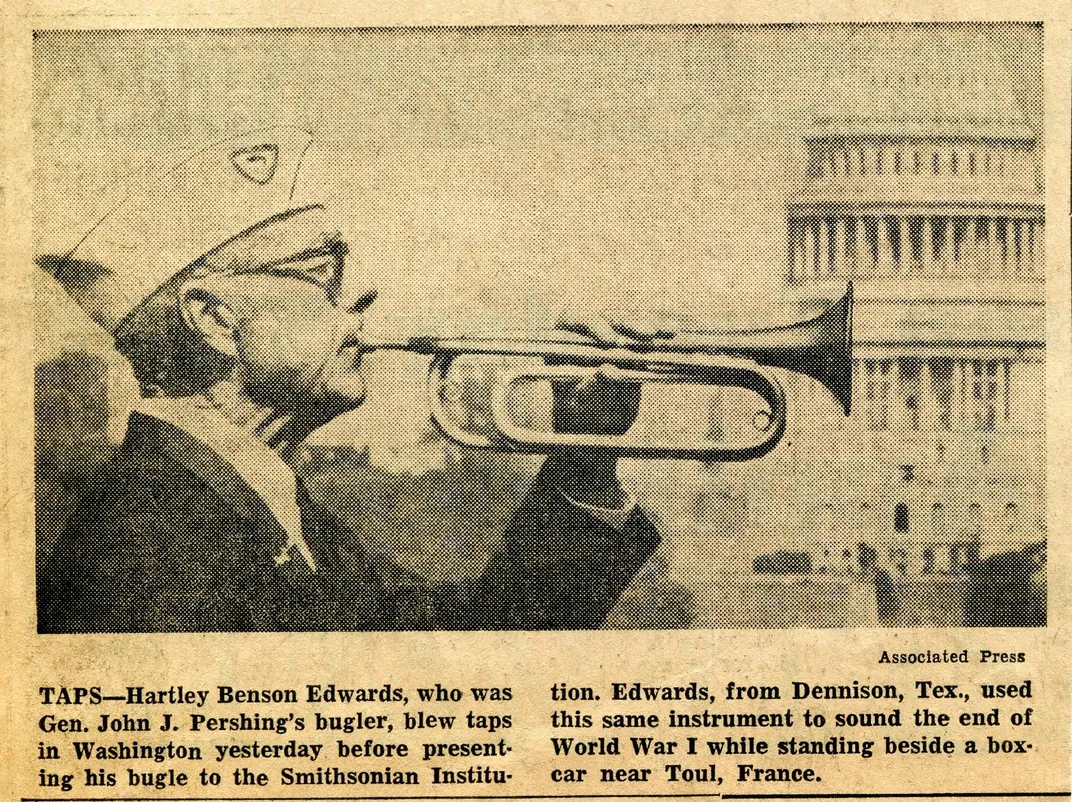
On June 5, 1917 in the town of Italy, Texas, a young farmer, Edwards registered for the Selective Service. Born in the nearby community of Forreston in 1896, Edwards entered the U.S. Army on May 27, 1918 at Camp Cody, near Deming, New Mexico, where the 34th Infantry Division had been training and preparing for service in Northern France. When he arrived, the Army assigned Edwards to Company K, 136th Infantry Regiment. Recalled Edwards in a 1967 interview for Texas Magazine, he had experience as a baritone horn player and hoped to join a unit band.
The first time that Edwards had ever even seen a bugle was that June 1 at Camp Cody, but upon learning of his musical background, Edward’s commanding officer thought the bugle would be a more appropriate instrument for the 22-year-old soldier. By October 12, 1918, when Company K boarded the Blue Funnel Line steamer SS Lycoan at port in Brooklyn, New York, Edwards was shipped “over there” as a U.S. Army bugler.
Arriving in France on October 24 after a 12-day voyage, the company completed the transfer of the 34th Division to France and the American Expeditionary Forces (AEF). Rather than enter combat, however, the division served as a replacement pool, with personnel sent to varying combat units to make up for the heavy losses incurred in the Meuse-Argonne Offensive.
The records are unclear, but at some point after his arrival, Edwards transferred to Company H, 59th Infantry Regiment, 4th Infantry Division. He arrived as his unit armed with an unadorned, 16-inch long, M1892 polished brass bugle manufactured by C.G. Conn Limited of Elkhart, Indiana, and a repertoire of bugle calls with which to signal the doughboys to an array of events or unexpected circumstances.
Music seems an unlikely element in war, but the AEF’s commander, General John J. Pershing, saw its value to the American doughboy. Historian David C. McCormick writes that Pershing “became convinced that music could have a positive effect upon army efficiency” and how “there was something more to music than mere window dressing for ceremonies.”
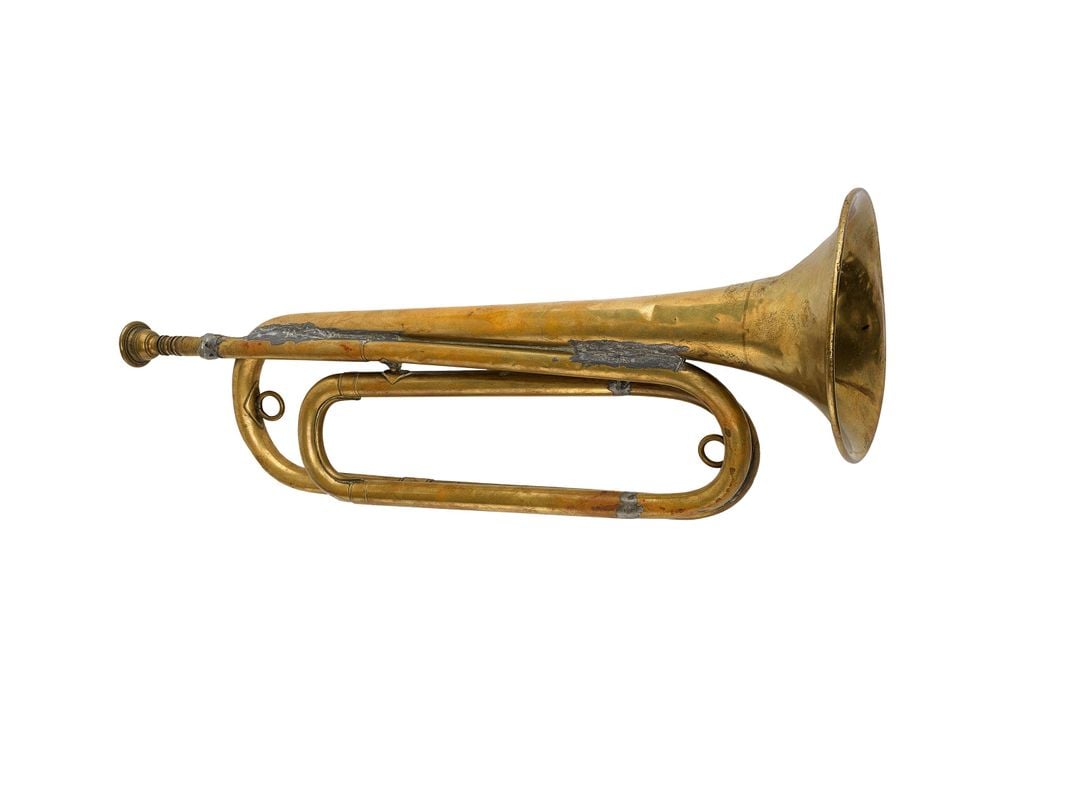
After encounters with elite French and English military bands in 1917, Pershing determined that the AEF needed similar organizations of superior quality. Throughout 1917 into 1918, he worked closely with the War Department to organize and equip bands and to select band members. A special AEF Bandmasters and Musicians Schools to improve musicians and bandleaders received Pershing’s approval and was established on October 28, 1918 in Chaumont, France, near Pershing’s headquarters. The school opened November 11, 1918.
That same day in a train carriage in the Forest of Compiegne, near Rethondes, France, a far greater event occurred. At 5:10 a.m., German representatives signed an Armistice before French and British military officers, bringing a temporary cessation to more than four years of bloodshed. No Americans were present. At 6:00 a.m. at his headquarters in Chaumont, Pershing received a phone message from Colonel T. Bentley Mott, his liaison officer at Marshal Ferdinand Foch’s headquarters announcing that the Armistice had been signed and for hostilities to cease at 11:00 a.m. Pershing notes in his diary: “This order was immediately transmitted to the Armies by telephone. It seems that both the First and Second Armies had planned attacks for this morning.” These attacks continued up through the eleventh hour and then ceased.
For the battle-fatigued men of the 4th Division, the Armistice must have come as a relief. Casualties had been heavy. Between mid-September and the 11th of November, the St. Mihiel and Meuse-Argonne offensives would claim more than 2,600 men with nearly 9,900 wounded in action.
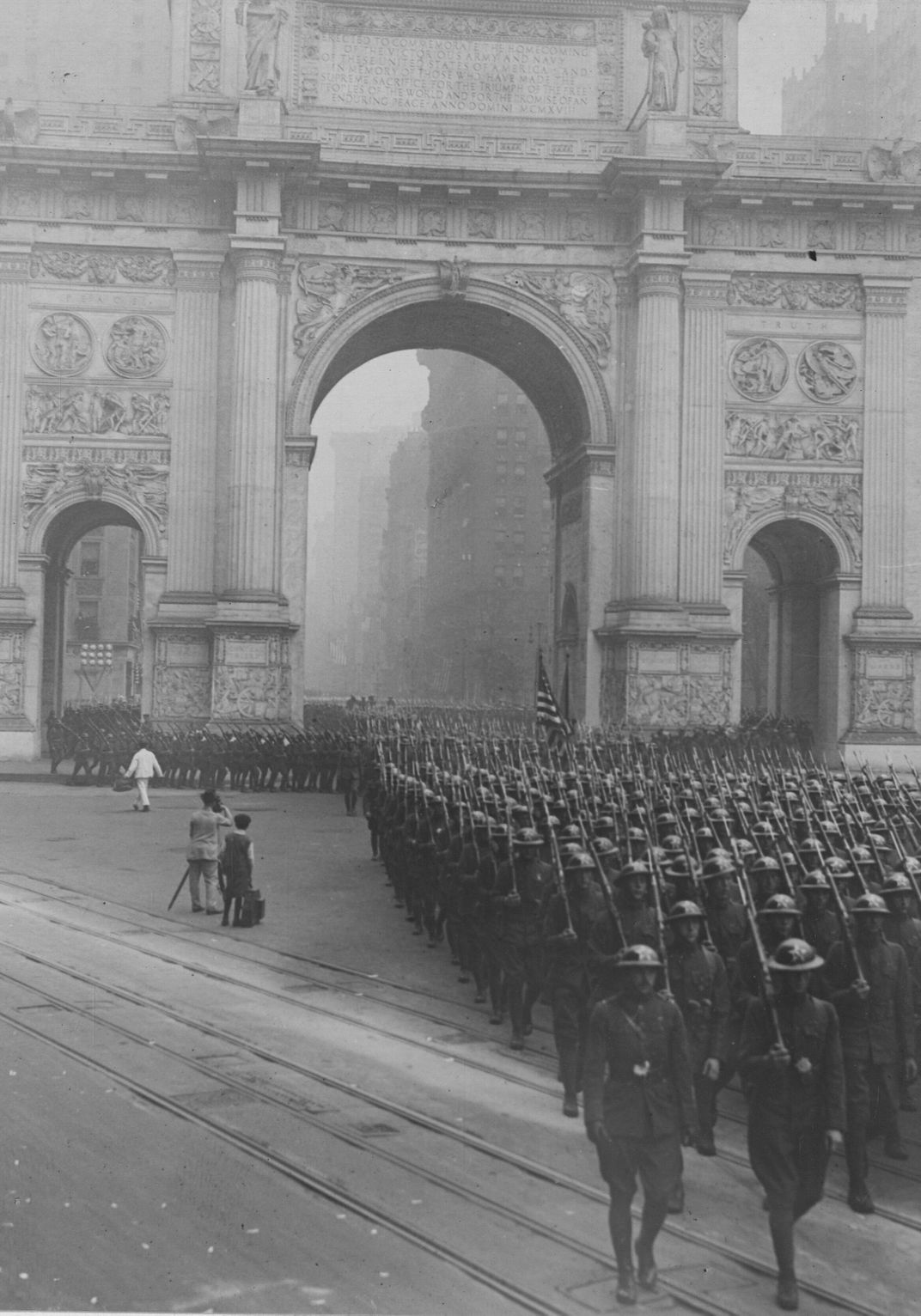
Back at headquarters, Pershing busied himself for the remainder of the day with discussions with his senior staff officers regarding the Armistice before heading on the 12th to Paris. The records of his activities that day show nothing more of interest.
With the shooting over, the long period of occupation brought performance opportunities for Pershing to showcase the AEF’s musical talents that were trained at the Bandmasters and Musicians School. A General Headquarters Band began operations in December 1918 and held concerts in Chaumont and elsewhere in Northern France. Pershing took great pride in the band, even making occasional musical requests.
The band’s star rose so rapidly that in April 1919 it travelled to the United States to participate in the Victory Loan campaign. From April 21 to May 10, the band toured the northeast to rave reviews, performing before crowds of thousands. Pershing requested the band return to Europe for a parade in London, but the War Department denied the commander’s request. Subsequently the band dissolved and musicians returned to civilian life.
Meanwhile, Pershing returned to Europe for additional ceremonies, notably a grand Allied victory parade (défilé de la Victoire) on Bastille Day, July 14, 1919 in Paris. Envisioning the AEF marching under the Arc de Triomphe and down the Avenue des Champs Elysees into the Place de la Concorde, Pershing wanted to outshine his Allies. He ordered the formation of an American Provisional Regiment, drawn from the Regular Army divisions in the Army of Occupation. The regiment selected men based on record, bearing and appearance (no man under 5’8” in height). Once assembled, the doughboys drilled to machine-like precision. The press deemed the provisional unit “Pershing’s Own” and with it came a special new band.
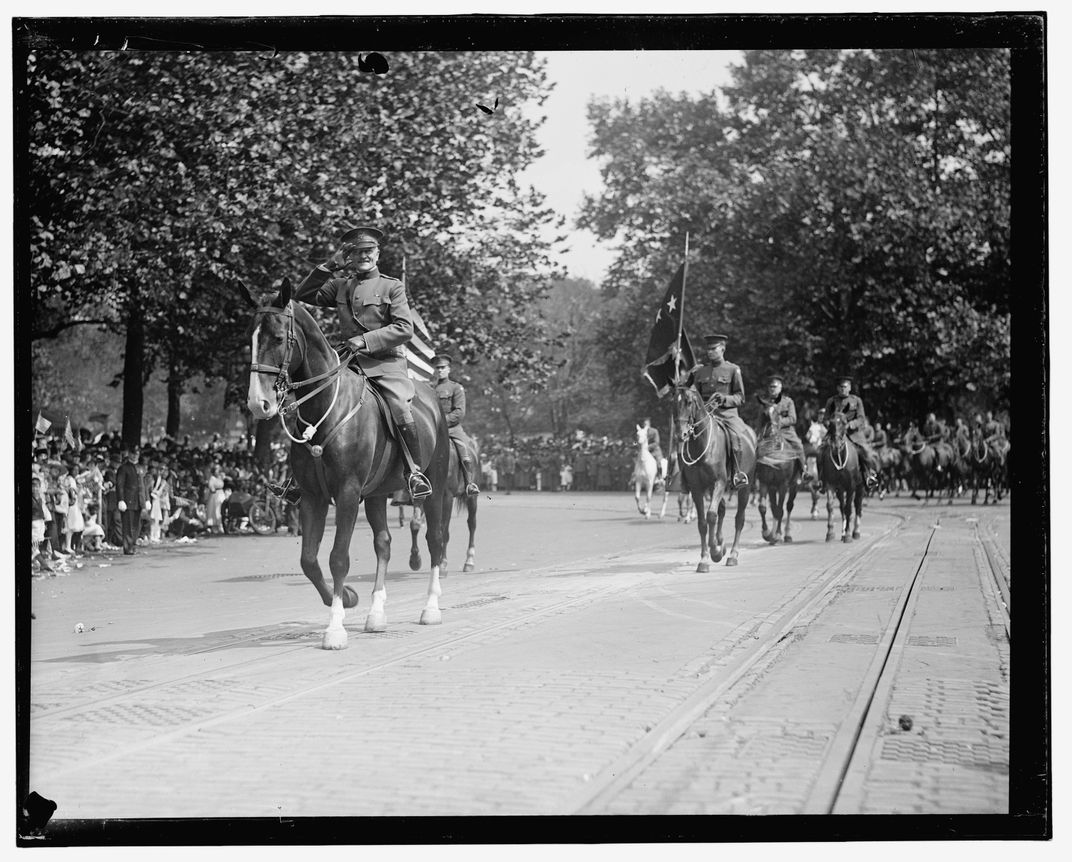
Organized as a composite battalion, the band formed around those musicians of the 4th Infantry Division, including Edwards, the bugler. Once assembled, the musicians drilled throughout May and June as rigorously as the marching regiment. Within the band’s drum and bugle corps, Edwards described how “they made us practice eight hours a day for 30 days. But when we were through we were a pretty sharp outfit.”
On Bastille Day 1919, the Americans formed up along the Avenue of the Grand Armée around dawn. The victory march began before 9:00 a.m. with the Americans at the front of the procession behind the French general Marshal Ferdinand Foch and Marshal Joseph Joffre. “All the pent-up emotion of France over the victorious ending of the war found vent today” wrote Richard V. Oulahan of the New York Times. Pershing rode at the head of this troops, followed by other senior American officers, the band and then the provisional regiment. After Pershing passed under Napoleon’s great victory arch—the first foreign general ever bestowed the honor—he and his staff saluted a temporary catafalque honoring the Allied dead.
It is probably at this moment that Edwards and the other American buglers blew “Taps” in honor of the fallen. This was the moment of glory that the bugle’s history represents. Here in triumph, American forces were honored for their service and their sacrifice.
At the conclusion of the grand parade, Foch mentioned to Pershing he hoped the American would return one day, a message Pershing passed along that Edwards remembers as “I hope that someday you men can return here and once again play taps for all of the soldiers who have been killed.”
From the grand spectacle in Paris, the parade tour continued. The provisional regiment traveled next to London, parading before King George V and the royal family on July 19.
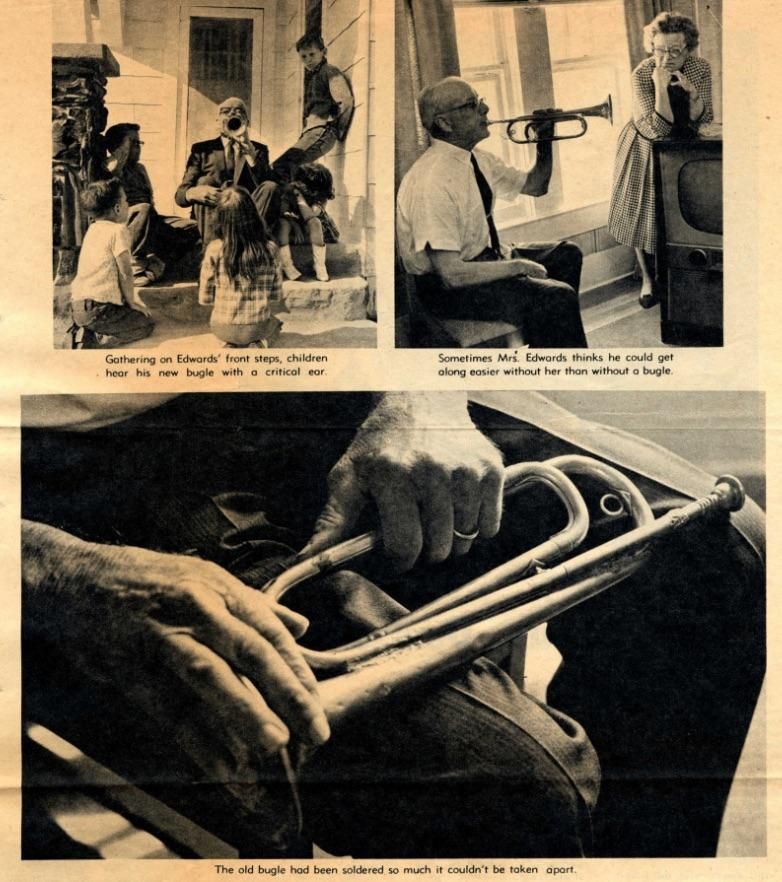
On September 1, Edwards, listed as a bugler in Company K of the “Third Army Composite Regiment,” boarded the massive passenger liner SS Leviathan and a week later arrived in Hoboken, New Jersey. Two days later, in an event described as probably “the greatest military spectacle” in the history of New York City, Pershing led his provisional regiment and band down Fifth Avenue to the cheers of their countrymen. One week later, Edwards and his bugle marched up Pennsylvania Avenue in Washington, D.C. in a National Victory Parade representing the last appearance of the American Expeditionary Forces.
The conclusion of the parade included Edwards’ departure from military service. Honorably Discharged on September 30, he returned to Italy, Texas, with his steel helmet and the bugle deemed too worn for the Army to retain.
After a few months back in Texas, Edwards tired of farming and moved north to Denison where he took up work as an oiler on the Missouri-Kansas-Texas Railroad. For the next 31 years he worked in the railroad and continued to play his horn, participating in the railroad’s drum and bugle corps for many years.
In 1956, a 61-year-old Edwards returned to Paris to fulfill Foch’s request. As part of the Woodrow Wilson Centennial observances, he blew “Taps” on November 11 at the Arc de Triomphe while wearing his 4th Infantry Division helmet, as he did 38 years before.
After returning from Paris, Edwards and his bugle informally toured the nation. At a variety of museums, military cemeteries and veteran reunions, Edwards blew “Taps.” His tour performances include two at Arlington National Cemetery by the grave of his personal hero, General Pershing.
At some point in the late 1950s to early 1960s, Edwards began to describe how he received an order straight from General Pershing on the morning of November 11, 1918 to blow “Taps” at 11:00 a.m. Although finding this unusual, Edwards executed the order faithfully. This particular aspect of Edwards’ story began to make its way into various press stories, surpassing his involvement in the 1919 victory parades. The C.G Conn Ltd musical instrument company learned of the bugle and hoped to acquire it for its musical instrument museum, offering to give Edwards a gold-plated replacement bugle in turn. The corporation approached the Smithsonian Institution asking curators if they would be interested in the bugle for the collection. Edwards agreed to donate it.
And so, on May 29, 1966, Edwards and his wife, Irene, arrived at the Smithsonian in the company of Congressman Ray Roberts of Texas. On the steps of the Museum of History and Technology (today’s National Museum of American History) facing the National Mall, Edwards blew one last “Taps” on his beloved bugle. After that last performance, Edwards handed the bugle to Roberts who accepted the instrument on behalf of the Smithsonian. Equipped with a suitable replacement courtesy of Conn, Edwards continued to blow “Reveille” and “Taps” from his home in Denison for the neighbors and for veterans’ functions in Texas until his death on November 14, 1978.
Memory is a masterful trickster. Edwards likely did play “Taps” on November 11, 1918 at sundown, as it was his duty to sound reveille. His inaccurate claim to have been ordered to blow “Taps” at 11:00 a.m. on November 11, 1918 perhaps stems from his deep admiration of General Pershing and that combined with a career commitment to the Great War made his apocryphal story more meaningful to him than describing his significant role and participation in the grand victory parades of 1919. Philosophically, these parades and Edwards’ later performances are where I see the true symbolic value of this bugle. Across the nation and in France, his humble brass instrument sounded to the world simple but hallowed chords representing America’s contribution in lives to the defense of democracy, at home and abroad.
As we approach the centennial of the Armistice, it is important to reflect upon the global ramifications of the conflict. In the foreword to his memoirs of the war, Pershing articulated his duty-bound obligation to record the story of the conflict and those he commanded. He wrote how in the World War, “Once realizing their obligations, the American people willingly sent their sons to battle; with unstinted generosity, they gave of their substance; and with fortitude bore the sacrifices that fell to their lot. They, too, served, and in their service inspired the armies to victory.” As both soldier and civilian, Edwards’ and his bugle provided an audible reminder to us all that the experiences and the sacrifices of World War I will never be forgotten. Please pause this November 11, 2018 and listen closely for the faint strains of “Taps” rippling through the ages, and remember.
*Editor's Note, 11/13/18: A previous version of this article included a caption that incorrectly identified the location for one of the parades as beneath the Arc de Triomphe in France. The image actually depicted a parade that took place in New York City beneath a replica of the Parisian monument.
/https://tf-cmsv2-smithsonianmag-media.s3.amazonaws.com/accounts/headshot/FrankBlazich.jpg)
/https://tf-cmsv2-smithsonianmag-media.s3.amazonaws.com/accounts/headshot/FrankBlazich.jpg)